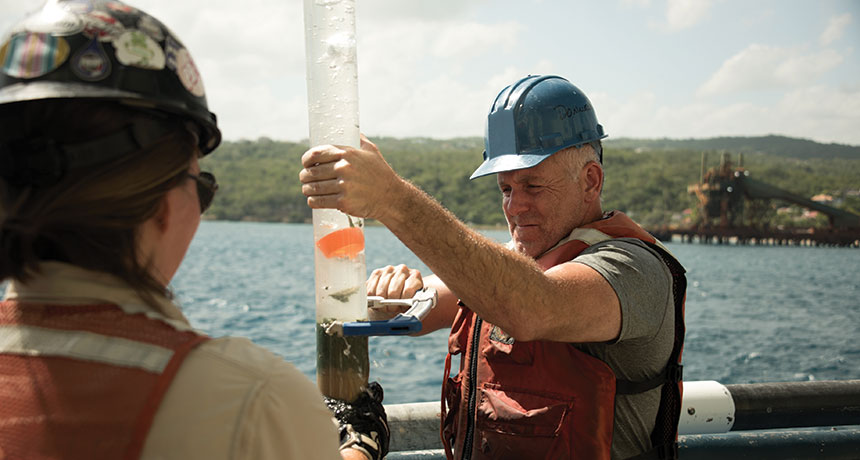‘Killer Hurricanes’ reconstructs the past to predict storms of the future
Historical, geologic records offer clues to tropical cyclones

STORM IN THE SAND A core of seafloor sediment collected off the coast of Jamaica by geologist Jeff Donnelly holds clues to prehistoric hurricanes.
Blink Films
In 1780, a powerful hurricane swept across the islands of the Caribbean, killing an estimated 22,000 people; 5,000 more died of starvation and disease in the aftermath. “Our planet is capable of unleashing extreme chaos,” begins the new NOVA documentary “Killer Hurricanes,” set to air November 1 on PBS.
To describe the human impact of such powerful tropical cyclones, the documentary primarily focuses on two storms: the Great Hurricane of 1780 and Hurricane Matthew, a Category 4 storm that slammed into Haiti and Cuba last October. Before the devastating 2017 Atlantic hurricane season (SN Online: 9/21/17), Matthew was considered the biggest Atlantic storm of the last decade.
Still, the film’s larger message remains timely: Studying the hurricanes of the past can offer insights into storms of the future — and, hopefully, help coastal and island communities prepare for such events.
The documentary describes the work of researchers as they examine both human and geologic records to track past cyclones. Because the Great Hurricane occurred during relatively recent history, researchers can use eyewitness accounts and ship records to estimate not only the size of the storm, but also to track its path and calculate the storm surge.
But geologists such as Jeff Donnelly of the Woods Hole Oceanographic Institution in Massachusetts and Amy Frappier of Skidmore College in Saratoga Springs, N.Y., are looking deeper into the past. Donnelly finds physical traces of prehistoric hurricanes buried in seafloor sediments, while Frappier detects chemical traces in stalagmites growing in caves across the Caribbean. These data reveal a troubling pattern: The frequency of strong hurricanes distinctly increases when ocean temperatures are warmer. What’s more, hurricanes’ paths have shifted northward over the last 450 years, moving closer to the contiguous United States.
As the film notes, ocean waters are now warming at a rapid rate. Meanwhile, sea levels are rising, and the water in the oceans expands as it warms. Both effects will augment the impact of storm surge from such cyclones.
“Killer Hurricanes” doesn’t break much new ground, and the film’s stark conclusion about the future paths and intensities of powerful cyclones is one that climate scientists have long been signaling. But coming on the heels of a deadly hurricane season, and with the United States’ future participation in the Paris climate accord in limbo (SN Online: 6/1/17), the film may serve as a powerful reminder of the human cost of climate change.







